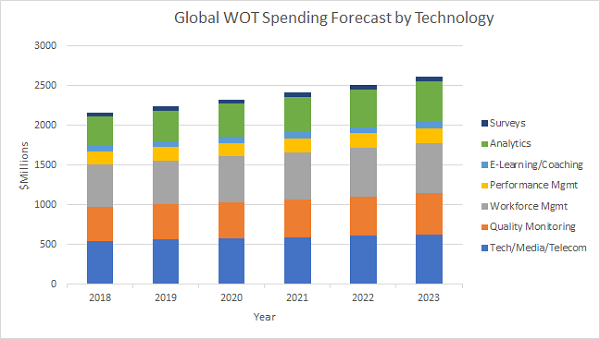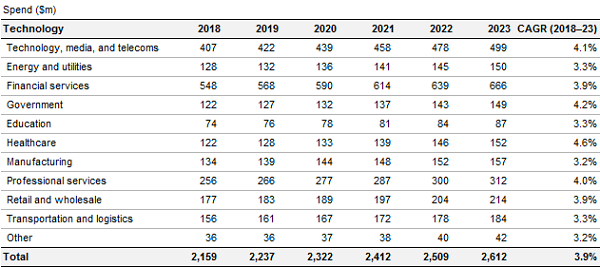While workforce optimization technology (WOT) has been widely available in the customer engagement marketplace for decades, it’s been evolving most rapidly in richness and customer acceptance during the last decade. An industry founded on the success of its workforce management (WFM) and call recording technologies has successfully broadened into several other WOT-related areas. Quality monitoring (QM), performance management (PM), e-learning, analytics, and survey tools have filled out the WOT management and monitoring toolset as enterprises more fully realize and appreciate the return on investment and enhanced customer/employee satisfaction level improvements achievable with the implementation of a strong WOT suite.
As the complement of WOT applications expands, and regional markets see significant growth in number of contact center implementations, the demand for a wider variety of WOT services continues to be strong across product technology and global regions. The demands of the customer engagement/customer service markets will continue to grow as newer significant and high-potential applications, such as analytics and performance management, drive up momentum in customer demand and spending priorities.
Despite the relative market maturity of WOT in North America and Western Europe, Ovum forecasts continued market growth in these regions as contact centers invest in new and advanced applications, upgrade to newer recording solutions, and add more sophisticated analytics functionality. Continued improvement of WOT capabilities, adoption by a broader range of businesses, and the need to meet increased compliance requirements, such as those imposed by the EU’s General Data Protection Regulation, continue to fuel market expansion. The underlying drivers of WOT expenditures are enterprise management’s desire to better understand customer demands and improve processes (survey and analytics tools), the need to better monitor and improve agent efficiency (e-learning, performance management, and workforce management), and the requirement for enterprises to implement and enforce compliance with core quality monitoring and call recording solutions.
Ovum’s recently completed WOT research and the resulting forecast, which covers the base year 2018 through the five-year period to 2023, predicts generally strong, although significantly different, five-year compound annual growth rates (CAGRs) across the five measured global regions of the world. In the more mature regional economies (i.e., North America and Europe), enterprises have, for several years, been implementing analytics tools to influence and push information to agents and customers in real time during customer interactions. They’re also using analytics more broadly with end-user surveys as they track and analyze customer satisfaction as an indicator of repeat business, customer loyalty, and longevity. The less mature WOT global regions of Asia and Oceana, Latin America and the Caribbean, and the Middle East and Africa continue to mature and expand into the traditional core as well as newer technologies.
The Ovum forecast for total global WOT spending by technology is shown in the figure below. Between 2018 and 2023, Ovum projects global WOT spending to increase at a CAGR of 3.9%, from $2.16 billion to $2.61 billion. The highest projected CAGR levels by product technology during the five-year forecast period are analytics (7.2%), QM (3.8%), and PM (3.6%).
The growth in QM and PM will continue as contact centers in the more mature markets focus on meeting government and industry compliance requirements, as well as meeting PCI credit card requirements. Vendors will continue selling quality monitoring as part of a package of compliance-focused WOT tools, including analytics.
In the emerging global economic regions — Asia and Oceana, Latin America and the Caribbean, and the Middle East and Africa — demand continues to grow for the core WFO applications: call recording, QM, and WFM. Contact centers in these regions are gradually beginning to increase investments in analytics and performance management as these markets grow and mature in customer engagement techniques and become more in demand for outsourcing. In addition, WFO vendors continue to expand the multi-language capabilities of their WOT technology suites to reach the developing markets in Eastern Europe and Asia, as demand for these WOT services increases in those regions.
On a global level the highest five-year vertical market growth for WOT over the forecast period, as depicted in the figure below, will include healthcare, government, technology/media/telecoms (TMT), and professional services, all growing at 4% or higher annually. Average CAGR over the forecast period for other verticals, albeit in some cases calculated on much smaller or larger base-year revenues, include financial services at 3.9%; retail/wholesale at 3.9%; and energy/utilities, education, and transportation/logistics each growing at 3.3% over the forecast period.
The increased growth rates indicate that end users operating in those vertical markets are gaining an appreciation of the capabilities afforded by WOT applications in terms of improving service levels, enhancing customer loyalty, cutting costs, and improving customer/employee satisfaction and overall customer engagement processes. They’re also likely to be a result of enhanced government or industry compliance requirements taking effect more broadly across these industries globally.
Manufacturing is at the lower end of WOT spending growth rates, with average CAGR of 3.2% or below, but still a healthy growth market. In absolute measurements of spending size, financial services, TMT, and professional services are today, and will remain, the largest WOT markets in total spending throughout the forecast period.
For enterprises in North America and Europe, already immersed in WFM and call recording solutions, Ovum expects an expansion of WOT solution sets into the quickly growing areas of analytics, quality monitoring, and performance management. It also expects that the lesser developed, more slowly growing WOT markets of the world, including Latin America and the Caribbean, Asia and Oceana, and the Middle East and Africa, will ramp up in sales across all the WOT market segments rather quickly in the coming two to three years as their domestic contact center and business markets grow and the industry is boosted by outsourcers capitalizing on these growth areas with large and less expensive employment resources.
Ovum recommends that enterprises wishing to stay competitive in customer experience management evaluate WOT solutions appropriate to their needs and move quickly to implement the offerings that best fit those needs and requirements. In addition, Ovum recommends that these enterprises think beyond their initial WOT solution requirements and seek out vendors that provide full suites of compatible WOT solutions for implementation as required over time. Healthcare, TMT, professional services, and financial services are the verticals in which we see the most pressing need for these WFO solutions to enable government and industry compliance, streamline processes, improve customer satisfaction, and lower overall operational costs.
As more enterprises adopt a broader set of WOT solutions beyond call recording and WFM into their contact centers, the trend of best-of-breed buying will continue to shift to the purchasing of WOT suites from a single supplier, or tightly-integrated groups of suppliers. The growing enterprise perception is that the suite approach better guarantees vendor service quality and consistency, delivers a single-point-of-contact approach to managing solutions, and provides the potential for discounted bulk pricing for multiple applications from the same vendor with a single point of support. Other emerging application trends in the customer engagement marketplace, such as the inclusion of AI and chatbots, the growing requirement of visualizing customer journeys, and the shifting of the regulatory and compliance landscape, will drive the marketplace to the newer WOT technologies and more tightly integrated suites of applications to ensure consistency and compatibility across enterprise operations.












